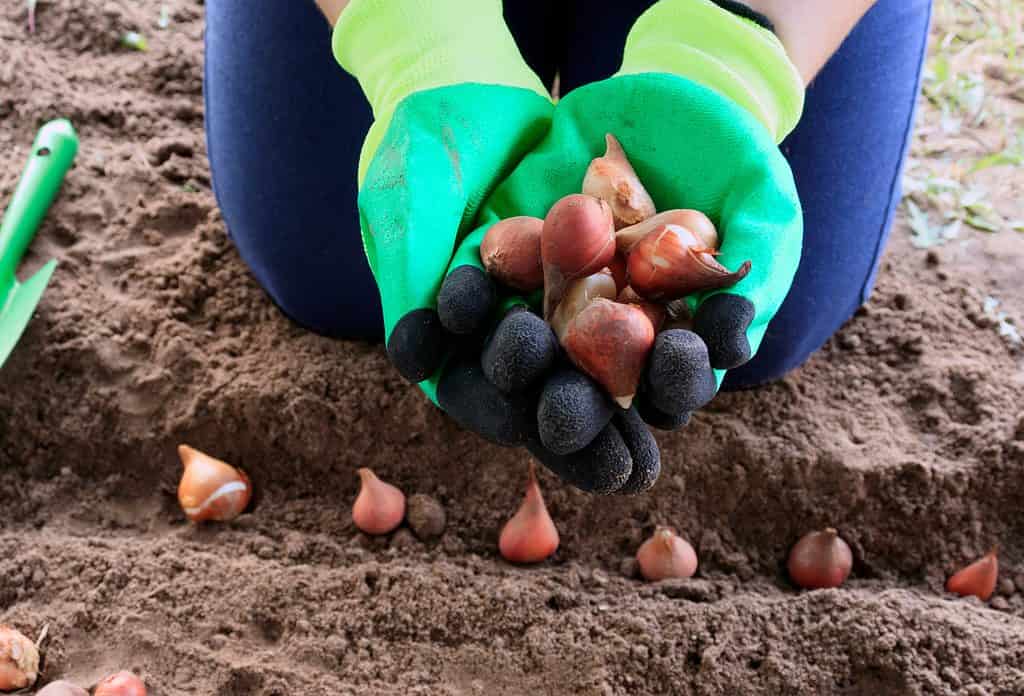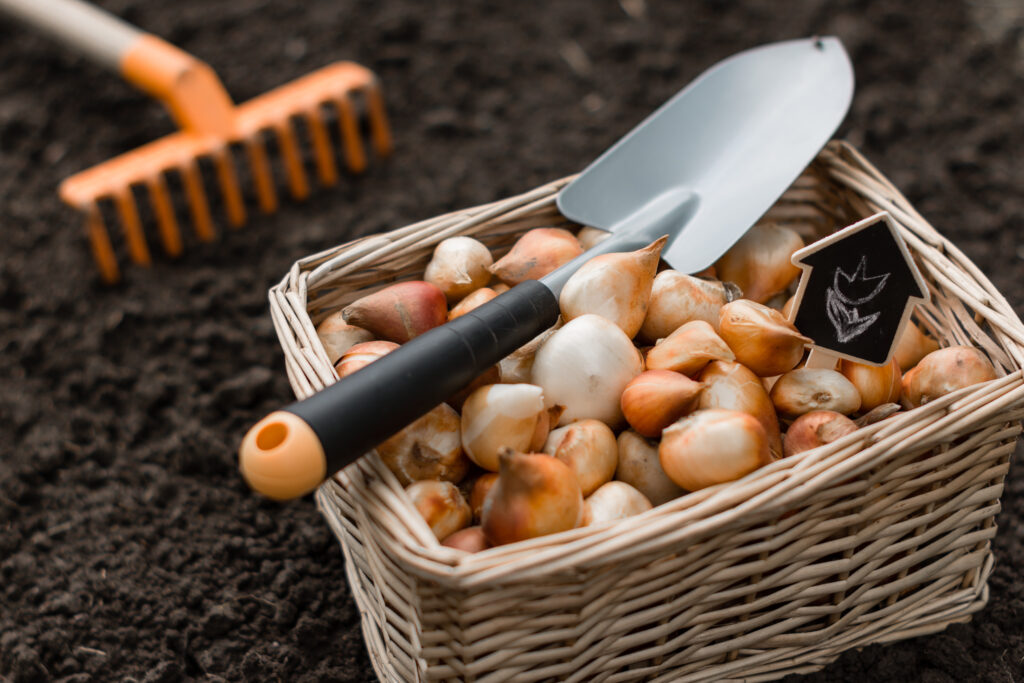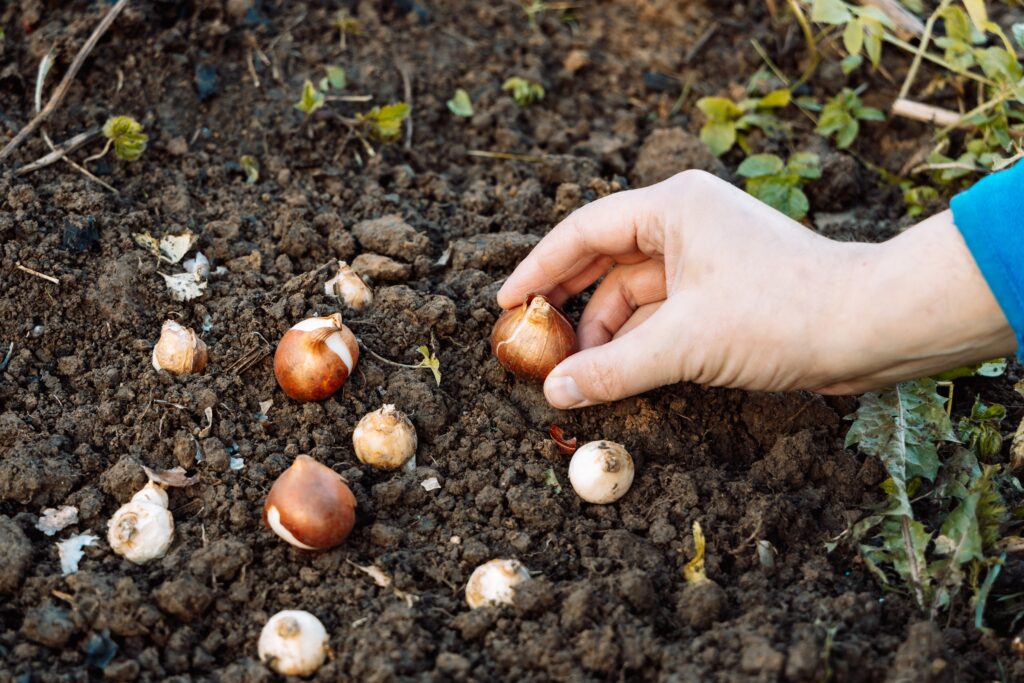Tulips are the picture of spring, invoking images of birds singing, blue skies, and lush greenery growing after a long winter. Yet, while spring is typically the planting season for most gardeners, tulips have unique planting requirements.
In this article, we’ll talk about when to plant tulip bulbs and how to promote growth all year long. Let’s dig in!

In this article, we’ll talk about when to plant tulip bulbs and how to promote growth all year long.
©Natallia Ustsinava/Shutterstock.com
Understanding Tulip Bulbs
Tulip bulbs are like little packages of promise, just waiting to bloom into bright and beautiful flowers. These bulbs are actually underground storage organs that store nutrients and energy for the tulip plant to use as it grows and eventually blooms.
When planted in the right conditions, tulip bulbs will grow and sprout, eventually producing the colorful petals we all know and love.
There are many different types of tulip bulbs, each with unique characteristics and planting requirements. Some bulbs, like the single early tulip, are small and delicate, while others, like the Darwin hybrid tulip, are larger and more robust.
Many tulip bulbs require a period of cold weather, known as vernalization, before they can bloom. You can also emulate this process in the fridge to force the bulbs when planting them off-season.
It’s important to choose the right type of tulip bulb for your garden and to follow the specific planting requirements for that particular variety. And, of course, buying high-quality bulbs is always a good idea to ensure the best possible results.
A healthy, robust bulb will produce a strong and vibrant tulip, so don’t be afraid to invest a little extra time and money into finding the right bulbs for your garden. Talk to your local florist or farmer for more information on the best bulbs for your climate.

It’s important to choose the right type of tulip bulb for your garden and to follow the specific planting requirements for that particular variety.
©Jurga Jot/Shutterstock.com
When to Plant Tulip Bulbs
Unlike most flowers, autumn is the ideal time to plant tulip bulbs — typically between late September and early November, depending on your location.
During the fall, the soil is still warm enough for the bulbs to develop roots but cool enough to prevent them from sprouting prematurely. Additionally, the ground isn’t yet frozen and unmanageable. By planting in the fall, you’re giving the bulbs ample time to establish strong root systems before the cold winter months set in.
Planting tulip bulbs at the right time is crucial for their growth and bloom quality. If planted too early, the bulbs may begin to sprout and then become damaged by frost or cold temperatures. If planted too late, they may not have enough time to develop strong roots before the coldest days of winter, which can lead to stunted growth or poor blooms come springtime.
It’s important to consider both your climate and location when determining the best time to plant in the fall. Look at your USDA zone to help you decide, and talk to local gardeners for a better idea.

Planting tulip bulbs at the right time is crucial for their growth and bloom quality.
©Natallia Ustsinava/Shutterstock.com
Planting Tulip Bulbs
Preparing the soil before planting is essential to give your tulip bulbs the best chance for success.
Start by removing any leftover dead plants or debris from the area where you plan to plant. This process will ensure the bulbs have enough space to grow and won’t have to compete for nutrients with other plants.
Removing dead and dying plants from the summer growing season also helps prevent pests and bacteria from infecting your bulbs.
Next, loosen the soil to a depth of at least 12 inches and mix in some compost or other organic matter to give the bulbs the nutrients they need to thrive. Remove rocks and roots from the plot as well.
When it’s time to plant your tulip bulbs, dig a hole about three times as deep as the bulb’s height. Then, place the bulb in the hole with the pointed end facing skyward. Cover it with soil, gently patting the dirt in place around the bulb to eliminate air bubbles.
Be sure to space your bulbs at least 4-6 inches apart to allow for proper growth and to avoid overcrowding. After planting, give the area a thorough watering to help settle the soil and provide moisture for the bulbs.

Preparing the soil before planting is essential to give your tulip bulbs the best chance for success.
©S.O.E/Shutterstock.com
Planting Tulips in the Spring
So what happens if you miss the fall planting season? No need to fret. You can vernalize your bulbs in the fridge or another cool, dry area.
How to Vernalize Your Bulbs:
- Choose a container with suitable drainage holes and fill it with a layer of potting soil.
- Gently place your tulip bulbs in the soil, ensuring they aren’t touching one other or the sides of the container.
- Cover the bulbs with another layer of soil, leaving about an inch of space at the top of the container.
- Water the soil until it is moist but not completely drenched.
- Seal the container with a lid or plastic wrap and place it where the temperature will remain between 35-45°F (2-7°C) for 12-16 weeks. This could be in a fridge, basement, garage, or outdoors in a sheltered area.
- Check on the bulbs periodically to ensure the soil remains moist and mold or mildew does not develop.
- After the vernalization period, remove the container from the cold location and plant your bulbs.
If you’re hoping your tulips will bloom in the spring that you plant them, try to vernalize them at least 12 weeks before the growing season. Then, plant them as soon as the ground thaws enough to dig.
Thank you for reading! Have some feedback for us? Contact the AZ Animals editorial team.








